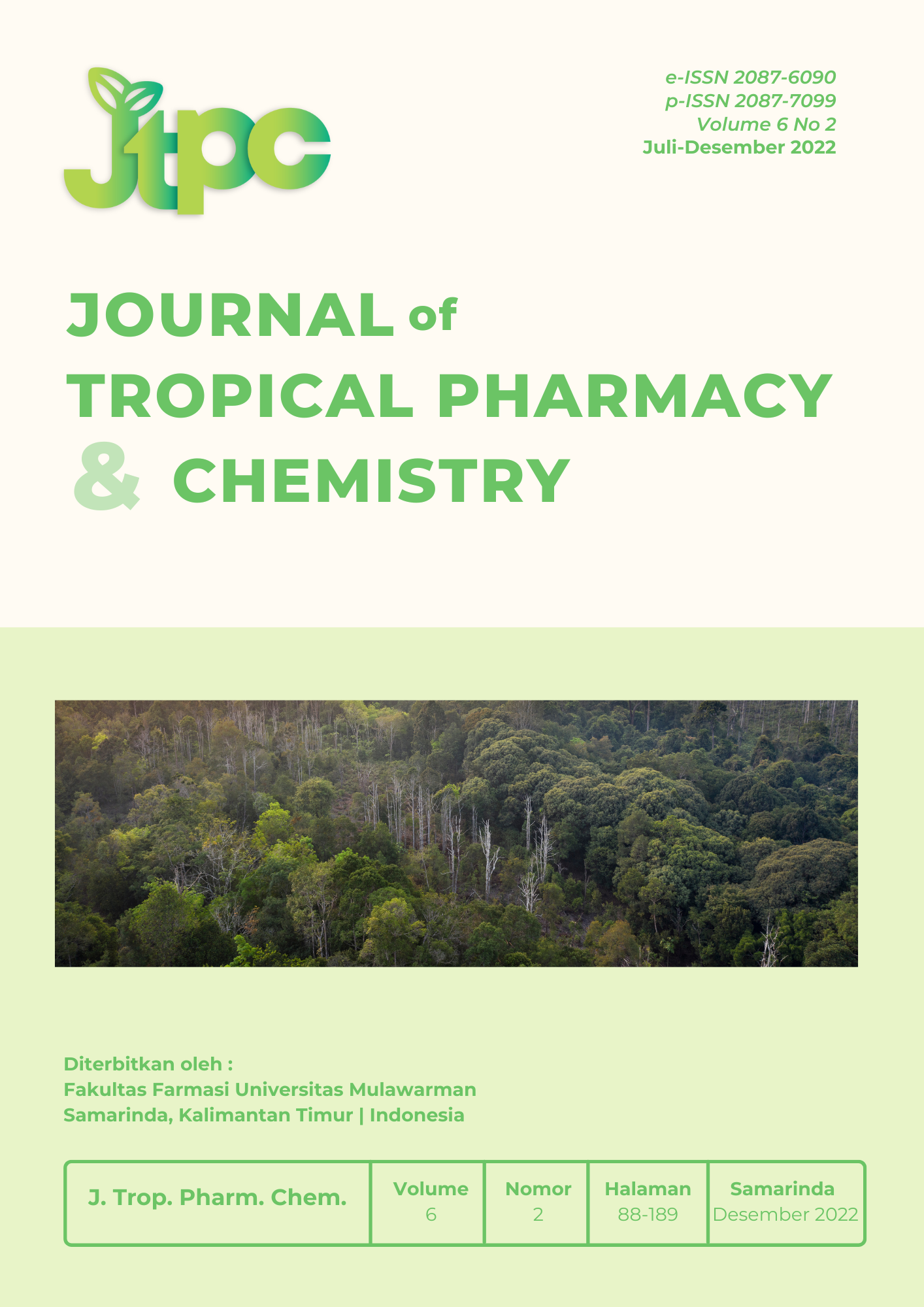6,7-dimethoxydihydrocoumarin Compound from Ethyl Acetate Extracts from Steambarks Dysoxylum Alliaceum and Cytotoxic Activity Against P-388
DOI:
https://doi.org/10.30872/j.trop.pharm.chem.v6i2.242Keywords:
Dysoxylum alliaceum, phenol, Bark, Spectroscopy, P-388Abstract
Dysoxylum is a genus that has a variety of secondary metabolites. Research on various species of this genus is always growing and producing compounds that have interesting structures and activities, until now many compounds of the terpenoid group, chroman alkaloids, limonoids, sesquiterpenes, flavonoids, steroids, protolimonoids and sulfur have been reported. which is very interesting. One of the Dysoxylum species that has a variety of secondary metabolites is D. alliaceum. The purpose of this study was to obtain secondary metabolites of D. alliaceum bark. The bark of D. alliaceum was macerated successively with n-hexane, ethyl acetate and methanol. The ethyl acetate extract was separated and purified by various chromatographic techniques and was characterized using spectroscopic methods including, ultraviolet, infrared, NMR and mass spectroscopy and guided by thin layer chromatographic analysis to obtain the compound 6,7-dimethoxydyhidrocoumarin and the proposed biogenesis. The chemical structure of these compounds has been determined based on the interpretation of spectroscopic data and compared with spectral data from previous studies. Cytotoxic activity test against P-388 MTT leukemia cells obtained an IC50 of 39.210 g/mL and was declared inactive.
Downloads
References
Mabberley, D.J., 2008. 14. Dysoxylum Blume, Bijdr. 172. 1825. FI.China 11, 125–129.
Najmuldeen, I.A., 2011. Phytochemical Studies and The Bioactivities Of Three Meliaceae Species. University Of Malaya Kuala Lumpur.
Mayanti,Tri., Achmad Z.,Sylvia R.M, Euis J., Jamaluddin A.A. Seskuiterpenoid Prostanterol dari Kulit Batang Dysoxylum excelsum. Chimica et Natura Acta Vol.7 No. 2, 2019:98-101
Kurimoto, S.I., Kashiwada, Y., Lee, K.H., Takaishi, Y., 2011. Triterpenes and a triterpene glucoside from Dysoxylum cumingianum. Phytochemistry 72, 2205–2211.
Wah, L.K., Abas, F., Cordell, G.A., Ito, H., Ismail, I.S., 2013. Steroids from Dysoxylum grande (Meliaceae) leaves. Steroids 78, 210–219.
Ting, T.,& Zhi, N.A., 2012. Chemical Constituents from Dysoxylum cauliflorum l MeliaceaeD. Nat. Prod. Res. 24, 6–8.
Wink, M., Ashour, M.L., El-Readi, M.Z., 2012. Secondary Metabolites From Plants Inhibiting Abc Transporters And Reversing Resistance Of Cancer Cells And Microbes To Cytotoxic And Antimicrobial Agents. Front. Microbiol. 3, 1–15.
Mohanakumara, P., Sreejayan, N., Priti, V., Ramesha, B.T., Ravikanth, G., Ganeshaiah, K.N., Vasudeva, R., Mohan, J., Santhoshkumar, T.R., Mishra, P.D., Ram, V., Shaanker, R.U., 2010. Dysoxylum binectariferum Hook.f (Meliaceae), a rich source of rohitukine. Fitoterapia 81, 145–148.
Tobin, G., Kalupahana, R., Kulka, M., 2012. Plant Based Natural Products and Breast Cancer?: Considering Multi-Faceted Disease Aspects , Past Successes, and Promising Future Interventions 30–40.
Nurcahyanti, Ois.,Tri, M, Euis, J., 2015. Senyawa Steroid Dari Kulit Batang Dysoxylum Alliaceum Dan Aktivitasnya Terhadap Sel Kanker Payudara Mcf-7. Chimica et Natura Acta Vol.3 No. 2, Agustus 2015:62-65
Mayanti,Tri., Achmad Z.,Sylvia R.M, Euis J., Jamaluddin A.A. Seskuiterpenoid Prostanterol dari Kulit Batang Dysoxylum excelsum. Chimica et Natura Acta Vol.7 No. 2, 2019:98-101
Alley, M.C., Scudiero, D.A., Monks, A., Hursey, M.L., Czerwinski, M.J., Fine, D.L., Abbott, B.J., Mayo, J.G., Shoemarker, R.H., & Boyd, M.R. 1998. Feasbility of drug screening with panels of human tumor cell line using a microculture tetrazolium assay. Cancer Res. 48, 589-601.
Li, X., Tong, S., Cheng, D., Li, Q., Yan, J., 2014. Coumarins from Edgeworthia chrysantha. molecules 19, 2042–2048.
Downloads
Published
Issue
Section
License
Copyright (c) 2022 Ois Nurcahyanti, Kartika Rahma (Author)

This work is licensed under a Creative Commons Attribution-NonCommercial 4.0 International License.




